Data Science for Business: Itineract Travel Co Report Analysis
VerifiedAdded on 2023/01/13
|21
|4318
|23
Report
AI Summary
This report presents a data science analysis of customer data from Itineract Travel Co, a company offering travel experiences. The analysis begins with an assessment of the briefing note, outlining the importance of data science in making informed decisions. The investigation involves exploratory data analysis (EDA) to identify trends and patterns in customer behavior, followed by inferential statistics like bootstrap analysis to quantify confidence intervals. Regression models are used to determine the satisfaction of customers visiting specific destinations. The report includes descriptive statistics, correlation analysis, and classification analysis to derive meaningful insights. Ethical and security considerations are also addressed, ensuring responsible handling of customer data. The findings provide recommendations for improving customer experience and optimizing business strategies, including the use of data science techniques for targeted recommendations. The report concludes by presenting potential solutions for the company.
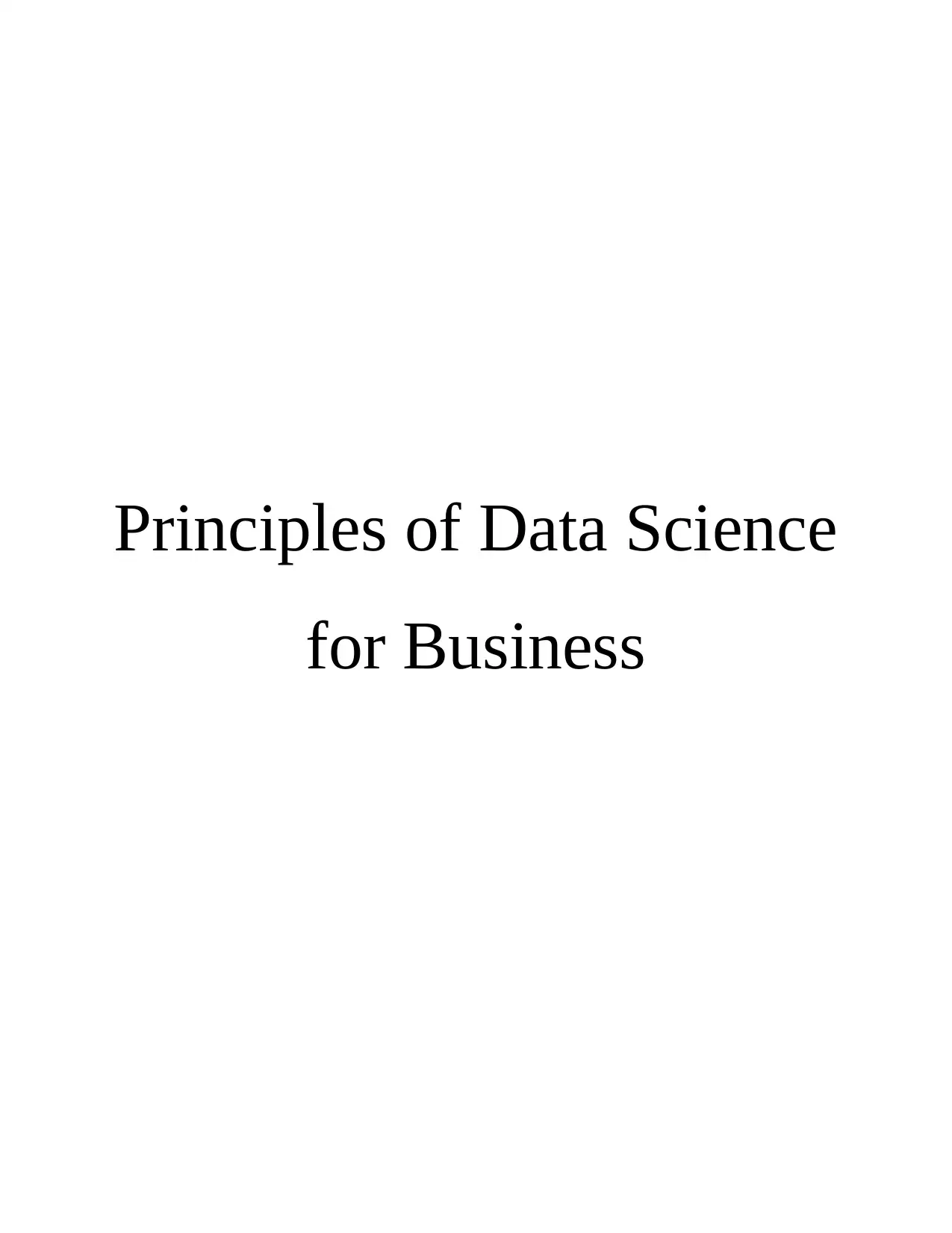
Principles of Data Science
for Business
for Business
Paraphrase This Document
Need a fresh take? Get an instant paraphrase of this document with our AI Paraphraser
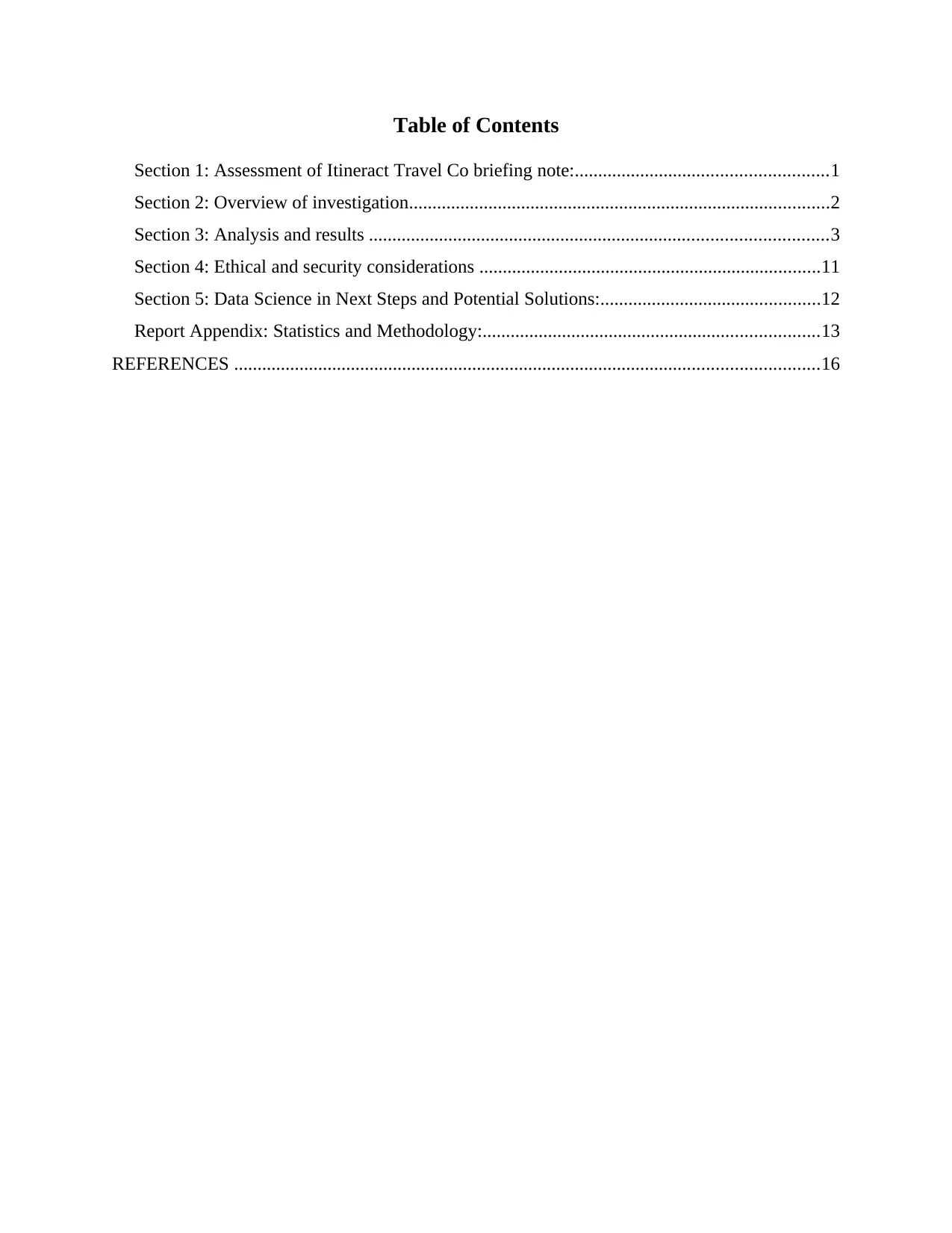
Table of Contents
Section 1: Assessment of Itineract Travel Co briefing note:......................................................1
Section 2: Overview of investigation..........................................................................................2
Section 3: Analysis and results ..................................................................................................3
Section 4: Ethical and security considerations .........................................................................11
Section 5: Data Science in Next Steps and Potential Solutions:...............................................12
Report Appendix: Statistics and Methodology:........................................................................13
REFERENCES .............................................................................................................................16
Section 1: Assessment of Itineract Travel Co briefing note:......................................................1
Section 2: Overview of investigation..........................................................................................2
Section 3: Analysis and results ..................................................................................................3
Section 4: Ethical and security considerations .........................................................................11
Section 5: Data Science in Next Steps and Potential Solutions:...............................................12
Report Appendix: Statistics and Methodology:........................................................................13
REFERENCES .............................................................................................................................16

⊘ This is a preview!⊘
Do you want full access?
Subscribe today to unlock all pages.

Trusted by 1+ million students worldwide
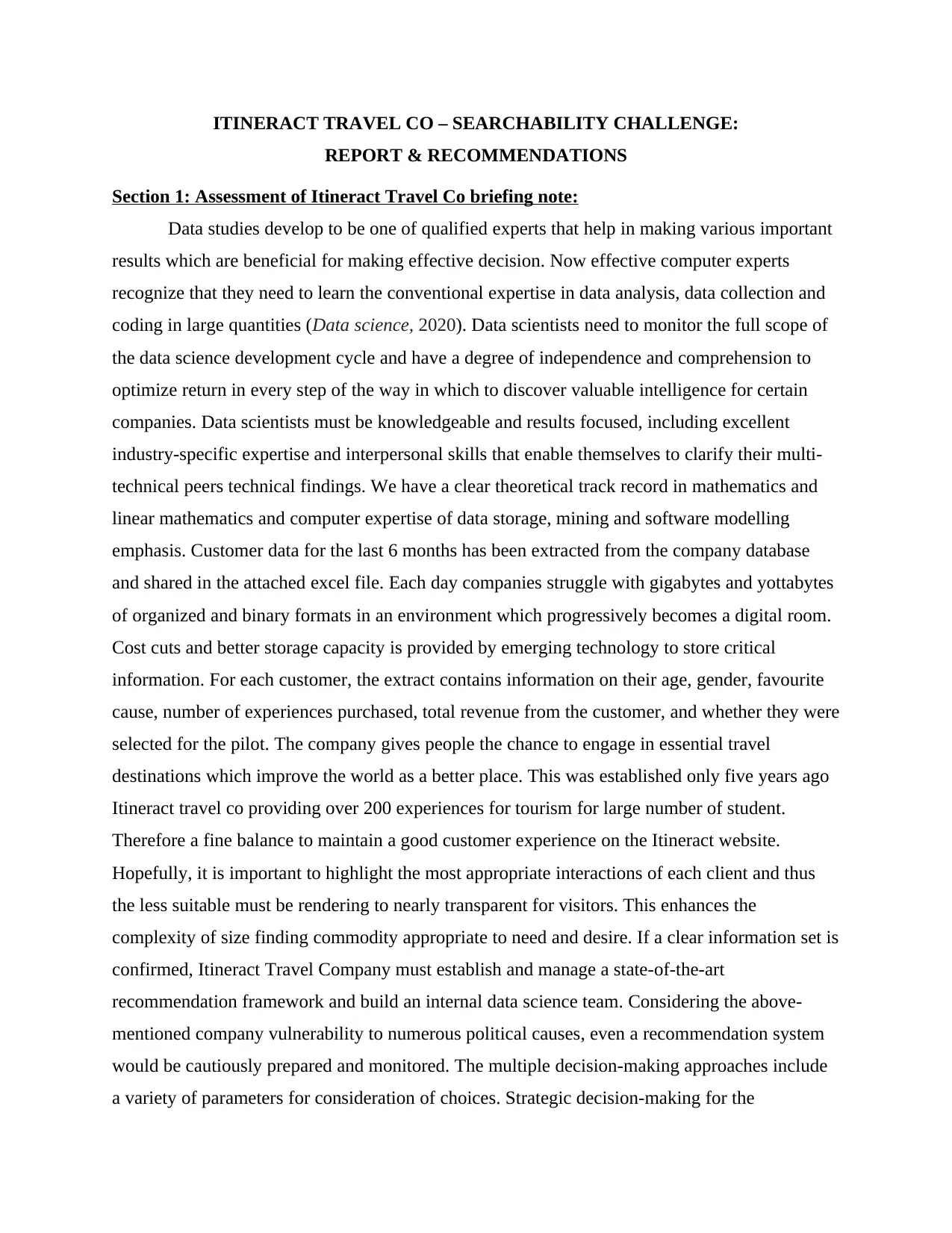
ITINERACT TRAVEL CO – SEARCHABILITY CHALLENGE:
REPORT & RECOMMENDATIONS
Section 1: Assessment of Itineract Travel Co briefing note:
Data studies develop to be one of qualified experts that help in making various important
results which are beneficial for making effective decision. Now effective computer experts
recognize that they need to learn the conventional expertise in data analysis, data collection and
coding in large quantities (Data science, 2020). Data scientists need to monitor the full scope of
the data science development cycle and have a degree of independence and comprehension to
optimize return in every step of the way in which to discover valuable intelligence for certain
companies. Data scientists must be knowledgeable and results focused, including excellent
industry-specific expertise and interpersonal skills that enable themselves to clarify their multi-
technical peers technical findings. We have a clear theoretical track record in mathematics and
linear mathematics and computer expertise of data storage, mining and software modelling
emphasis. Customer data for the last 6 months has been extracted from the company database
and shared in the attached excel file. Each day companies struggle with gigabytes and yottabytes
of organized and binary formats in an environment which progressively becomes a digital room.
Cost cuts and better storage capacity is provided by emerging technology to store critical
information. For each customer, the extract contains information on their age, gender, favourite
cause, number of experiences purchased, total revenue from the customer, and whether they were
selected for the pilot. The company gives people the chance to engage in essential travel
destinations which improve the world as a better place. This was established only five years ago
Itineract travel co providing over 200 experiences for tourism for large number of student.
Therefore a fine balance to maintain a good customer experience on the Itineract website.
Hopefully, it is important to highlight the most appropriate interactions of each client and thus
the less suitable must be rendering to nearly transparent for visitors. This enhances the
complexity of size finding commodity appropriate to need and desire. If a clear information set is
confirmed, Itineract Travel Company must establish and manage a state-of-the-art
recommendation framework and build an internal data science team. Considering the above-
mentioned company vulnerability to numerous political causes, even a recommendation system
would be cautiously prepared and monitored. The multiple decision-making approaches include
a variety of parameters for consideration of choices. Strategic decision-making for the
REPORT & RECOMMENDATIONS
Section 1: Assessment of Itineract Travel Co briefing note:
Data studies develop to be one of qualified experts that help in making various important
results which are beneficial for making effective decision. Now effective computer experts
recognize that they need to learn the conventional expertise in data analysis, data collection and
coding in large quantities (Data science, 2020). Data scientists need to monitor the full scope of
the data science development cycle and have a degree of independence and comprehension to
optimize return in every step of the way in which to discover valuable intelligence for certain
companies. Data scientists must be knowledgeable and results focused, including excellent
industry-specific expertise and interpersonal skills that enable themselves to clarify their multi-
technical peers technical findings. We have a clear theoretical track record in mathematics and
linear mathematics and computer expertise of data storage, mining and software modelling
emphasis. Customer data for the last 6 months has been extracted from the company database
and shared in the attached excel file. Each day companies struggle with gigabytes and yottabytes
of organized and binary formats in an environment which progressively becomes a digital room.
Cost cuts and better storage capacity is provided by emerging technology to store critical
information. For each customer, the extract contains information on their age, gender, favourite
cause, number of experiences purchased, total revenue from the customer, and whether they were
selected for the pilot. The company gives people the chance to engage in essential travel
destinations which improve the world as a better place. This was established only five years ago
Itineract travel co providing over 200 experiences for tourism for large number of student.
Therefore a fine balance to maintain a good customer experience on the Itineract website.
Hopefully, it is important to highlight the most appropriate interactions of each client and thus
the less suitable must be rendering to nearly transparent for visitors. This enhances the
complexity of size finding commodity appropriate to need and desire. If a clear information set is
confirmed, Itineract Travel Company must establish and manage a state-of-the-art
recommendation framework and build an internal data science team. Considering the above-
mentioned company vulnerability to numerous political causes, even a recommendation system
would be cautiously prepared and monitored. The multiple decision-making approaches include
a variety of parameters for consideration of choices. Strategic decision-making for the
Paraphrase This Document
Need a fresh take? Get an instant paraphrase of this document with our AI Paraphraser
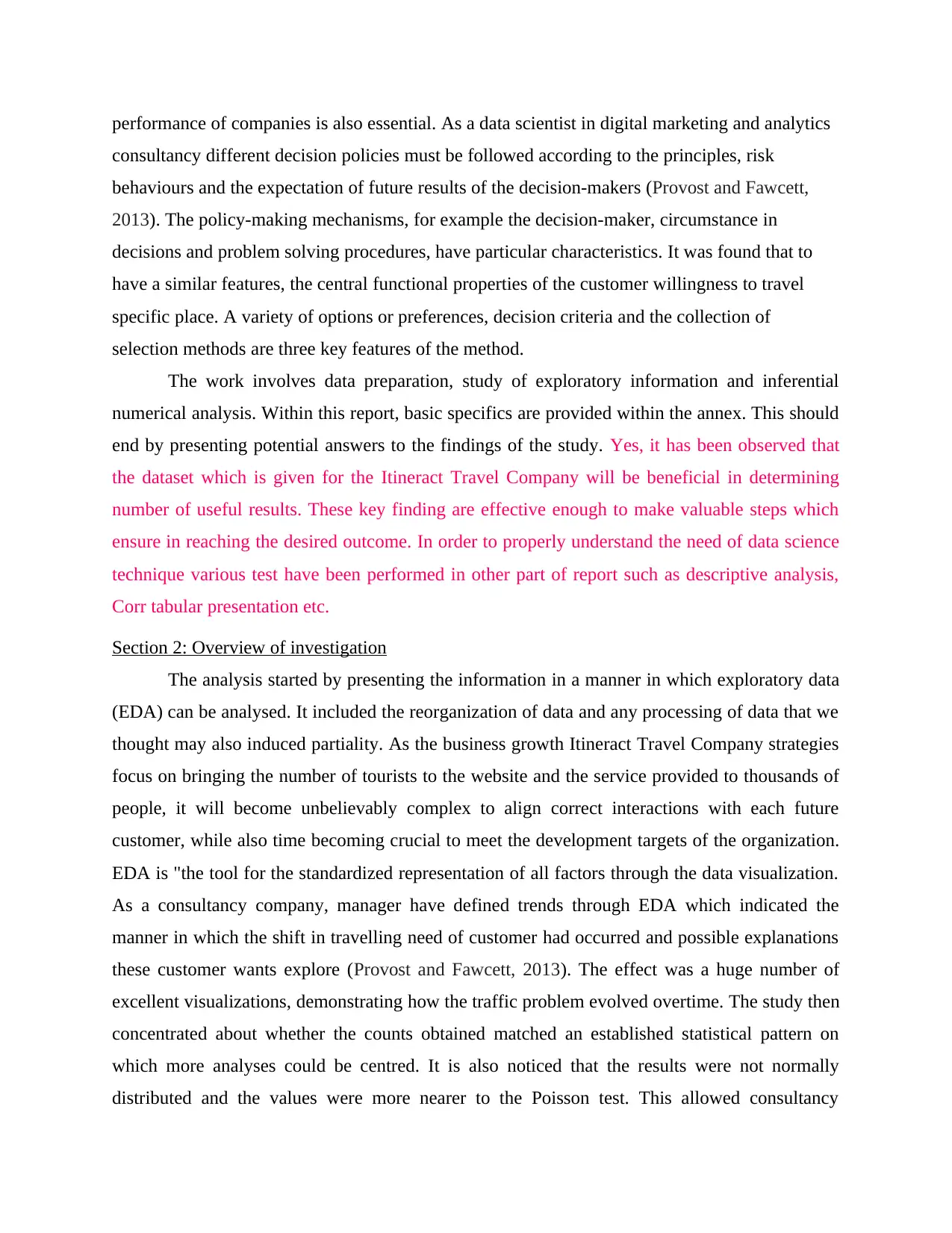
performance of companies is also essential. As a data scientist in digital marketing and analytics
consultancy different decision policies must be followed according to the principles, risk
behaviours and the expectation of future results of the decision-makers (Provost and Fawcett,
2013). The policy-making mechanisms, for example the decision-maker, circumstance in
decisions and problem solving procedures, have particular characteristics. It was found that to
have a similar features, the central functional properties of the customer willingness to travel
specific place. A variety of options or preferences, decision criteria and the collection of
selection methods are three key features of the method.
The work involves data preparation, study of exploratory information and inferential
numerical analysis. Within this report, basic specifics are provided within the annex. This should
end by presenting potential answers to the findings of the study. Yes, it has been observed that
the dataset which is given for the Itineract Travel Company will be beneficial in determining
number of useful results. These key finding are effective enough to make valuable steps which
ensure in reaching the desired outcome. In order to properly understand the need of data science
technique various test have been performed in other part of report such as descriptive analysis,
Corr tabular presentation etc.
Section 2: Overview of investigation
The analysis started by presenting the information in a manner in which exploratory data
(EDA) can be analysed. It included the reorganization of data and any processing of data that we
thought may also induced partiality. As the business growth Itineract Travel Company strategies
focus on bringing the number of tourists to the website and the service provided to thousands of
people, it will become unbelievably complex to align correct interactions with each future
customer, while also time becoming crucial to meet the development targets of the organization.
EDA is "the tool for the standardized representation of all factors through the data visualization.
As a consultancy company, manager have defined trends through EDA which indicated the
manner in which the shift in travelling need of customer had occurred and possible explanations
these customer wants explore (Provost and Fawcett, 2013). The effect was a huge number of
excellent visualizations, demonstrating how the traffic problem evolved overtime. The study then
concentrated about whether the counts obtained matched an established statistical pattern on
which more analyses could be centred. It is also noticed that the results were not normally
distributed and the values were more nearer to the Poisson test. This allowed consultancy
consultancy different decision policies must be followed according to the principles, risk
behaviours and the expectation of future results of the decision-makers (Provost and Fawcett,
2013). The policy-making mechanisms, for example the decision-maker, circumstance in
decisions and problem solving procedures, have particular characteristics. It was found that to
have a similar features, the central functional properties of the customer willingness to travel
specific place. A variety of options or preferences, decision criteria and the collection of
selection methods are three key features of the method.
The work involves data preparation, study of exploratory information and inferential
numerical analysis. Within this report, basic specifics are provided within the annex. This should
end by presenting potential answers to the findings of the study. Yes, it has been observed that
the dataset which is given for the Itineract Travel Company will be beneficial in determining
number of useful results. These key finding are effective enough to make valuable steps which
ensure in reaching the desired outcome. In order to properly understand the need of data science
technique various test have been performed in other part of report such as descriptive analysis,
Corr tabular presentation etc.
Section 2: Overview of investigation
The analysis started by presenting the information in a manner in which exploratory data
(EDA) can be analysed. It included the reorganization of data and any processing of data that we
thought may also induced partiality. As the business growth Itineract Travel Company strategies
focus on bringing the number of tourists to the website and the service provided to thousands of
people, it will become unbelievably complex to align correct interactions with each future
customer, while also time becoming crucial to meet the development targets of the organization.
EDA is "the tool for the standardized representation of all factors through the data visualization.
As a consultancy company, manager have defined trends through EDA which indicated the
manner in which the shift in travelling need of customer had occurred and possible explanations
these customer wants explore (Provost and Fawcett, 2013). The effect was a huge number of
excellent visualizations, demonstrating how the traffic problem evolved overtime. The study then
concentrated about whether the counts obtained matched an established statistical pattern on
which more analyses could be centred. It is also noticed that the results were not normally
distributed and the values were more nearer to the Poisson test. This allowed consultancy
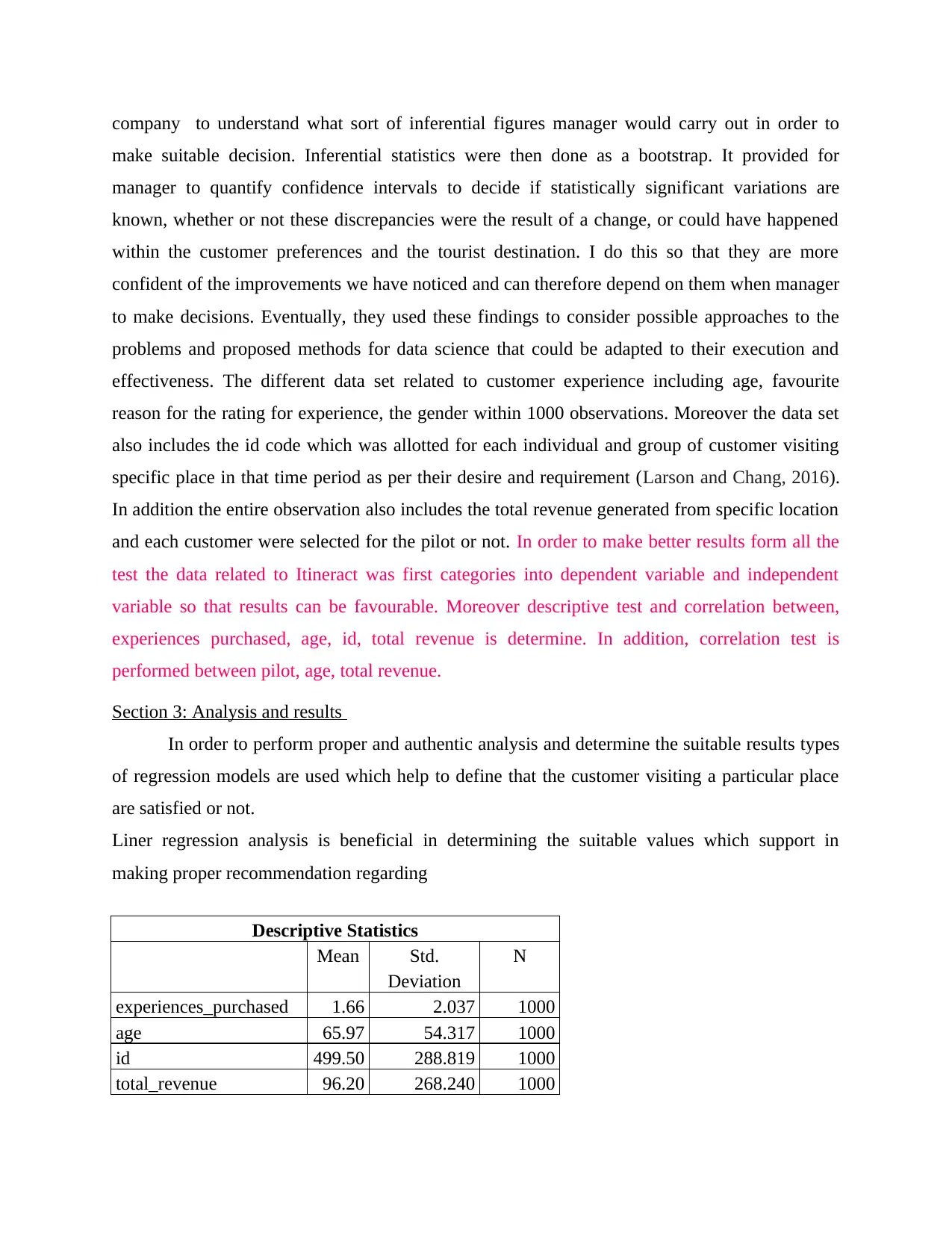
company to understand what sort of inferential figures manager would carry out in order to
make suitable decision. Inferential statistics were then done as a bootstrap. It provided for
manager to quantify confidence intervals to decide if statistically significant variations are
known, whether or not these discrepancies were the result of a change, or could have happened
within the customer preferences and the tourist destination. I do this so that they are more
confident of the improvements we have noticed and can therefore depend on them when manager
to make decisions. Eventually, they used these findings to consider possible approaches to the
problems and proposed methods for data science that could be adapted to their execution and
effectiveness. The different data set related to customer experience including age, favourite
reason for the rating for experience, the gender within 1000 observations. Moreover the data set
also includes the id code which was allotted for each individual and group of customer visiting
specific place in that time period as per their desire and requirement (Larson and Chang, 2016).
In addition the entire observation also includes the total revenue generated from specific location
and each customer were selected for the pilot or not. In order to make better results form all the
test the data related to Itineract was first categories into dependent variable and independent
variable so that results can be favourable. Moreover descriptive test and correlation between,
experiences purchased, age, id, total revenue is determine. In addition, correlation test is
performed between pilot, age, total revenue.
Section 3: Analysis and results
In order to perform proper and authentic analysis and determine the suitable results types
of regression models are used which help to define that the customer visiting a particular place
are satisfied or not.
Liner regression analysis is beneficial in determining the suitable values which support in
making proper recommendation regarding
Descriptive Statistics
Mean Std.
Deviation
N
experiences_purchased 1.66 2.037 1000
age 65.97 54.317 1000
id 499.50 288.819 1000
total_revenue 96.20 268.240 1000
make suitable decision. Inferential statistics were then done as a bootstrap. It provided for
manager to quantify confidence intervals to decide if statistically significant variations are
known, whether or not these discrepancies were the result of a change, or could have happened
within the customer preferences and the tourist destination. I do this so that they are more
confident of the improvements we have noticed and can therefore depend on them when manager
to make decisions. Eventually, they used these findings to consider possible approaches to the
problems and proposed methods for data science that could be adapted to their execution and
effectiveness. The different data set related to customer experience including age, favourite
reason for the rating for experience, the gender within 1000 observations. Moreover the data set
also includes the id code which was allotted for each individual and group of customer visiting
specific place in that time period as per their desire and requirement (Larson and Chang, 2016).
In addition the entire observation also includes the total revenue generated from specific location
and each customer were selected for the pilot or not. In order to make better results form all the
test the data related to Itineract was first categories into dependent variable and independent
variable so that results can be favourable. Moreover descriptive test and correlation between,
experiences purchased, age, id, total revenue is determine. In addition, correlation test is
performed between pilot, age, total revenue.
Section 3: Analysis and results
In order to perform proper and authentic analysis and determine the suitable results types
of regression models are used which help to define that the customer visiting a particular place
are satisfied or not.
Liner regression analysis is beneficial in determining the suitable values which support in
making proper recommendation regarding
Descriptive Statistics
Mean Std.
Deviation
N
experiences_purchased 1.66 2.037 1000
age 65.97 54.317 1000
id 499.50 288.819 1000
total_revenue 96.20 268.240 1000
⊘ This is a preview!⊘
Do you want full access?
Subscribe today to unlock all pages.

Trusted by 1+ million students worldwide
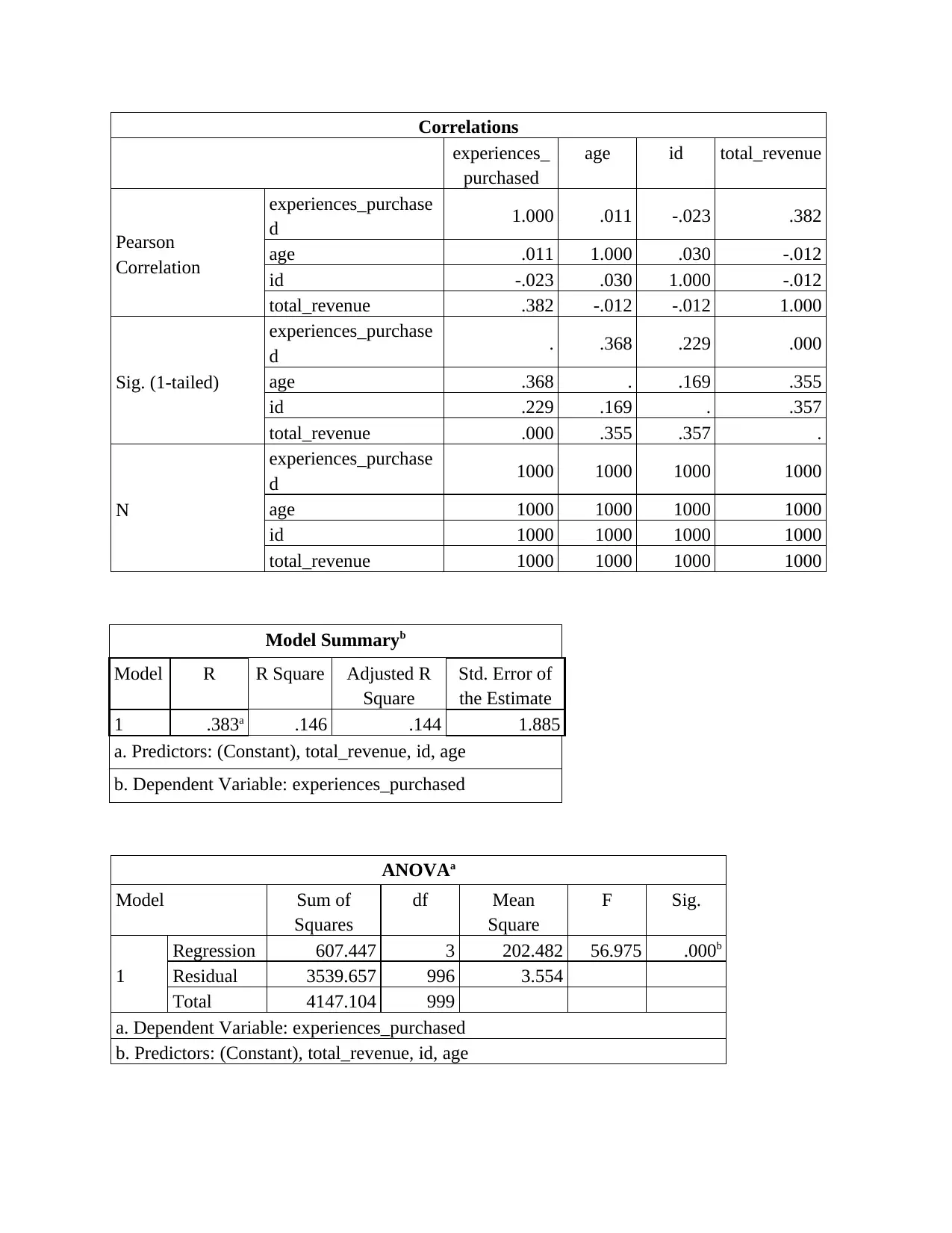
Correlations
experiences_
purchased
age id total_revenue
Pearson
Correlation
experiences_purchase
d 1.000 .011 -.023 .382
age .011 1.000 .030 -.012
id -.023 .030 1.000 -.012
total_revenue .382 -.012 -.012 1.000
Sig. (1-tailed)
experiences_purchase
d . .368 .229 .000
age .368 . .169 .355
id .229 .169 . .357
total_revenue .000 .355 .357 .
N
experiences_purchase
d 1000 1000 1000 1000
age 1000 1000 1000 1000
id 1000 1000 1000 1000
total_revenue 1000 1000 1000 1000
Model Summaryb
Model R R Square Adjusted R
Square
Std. Error of
the Estimate
1 .383a .146 .144 1.885
a. Predictors: (Constant), total_revenue, id, age
b. Dependent Variable: experiences_purchased
ANOVAa
Model Sum of
Squares
df Mean
Square
F Sig.
1
Regression 607.447 3 202.482 56.975 .000b
Residual 3539.657 996 3.554
Total 4147.104 999
a. Dependent Variable: experiences_purchased
b. Predictors: (Constant), total_revenue, id, age
experiences_
purchased
age id total_revenue
Pearson
Correlation
experiences_purchase
d 1.000 .011 -.023 .382
age .011 1.000 .030 -.012
id -.023 .030 1.000 -.012
total_revenue .382 -.012 -.012 1.000
Sig. (1-tailed)
experiences_purchase
d . .368 .229 .000
age .368 . .169 .355
id .229 .169 . .357
total_revenue .000 .355 .357 .
N
experiences_purchase
d 1000 1000 1000 1000
age 1000 1000 1000 1000
id 1000 1000 1000 1000
total_revenue 1000 1000 1000 1000
Model Summaryb
Model R R Square Adjusted R
Square
Std. Error of
the Estimate
1 .383a .146 .144 1.885
a. Predictors: (Constant), total_revenue, id, age
b. Dependent Variable: experiences_purchased
ANOVAa
Model Sum of
Squares
df Mean
Square
F Sig.
1
Regression 607.447 3 202.482 56.975 .000b
Residual 3539.657 996 3.554
Total 4147.104 999
a. Dependent Variable: experiences_purchased
b. Predictors: (Constant), total_revenue, id, age
Paraphrase This Document
Need a fresh take? Get an instant paraphrase of this document with our AI Paraphraser
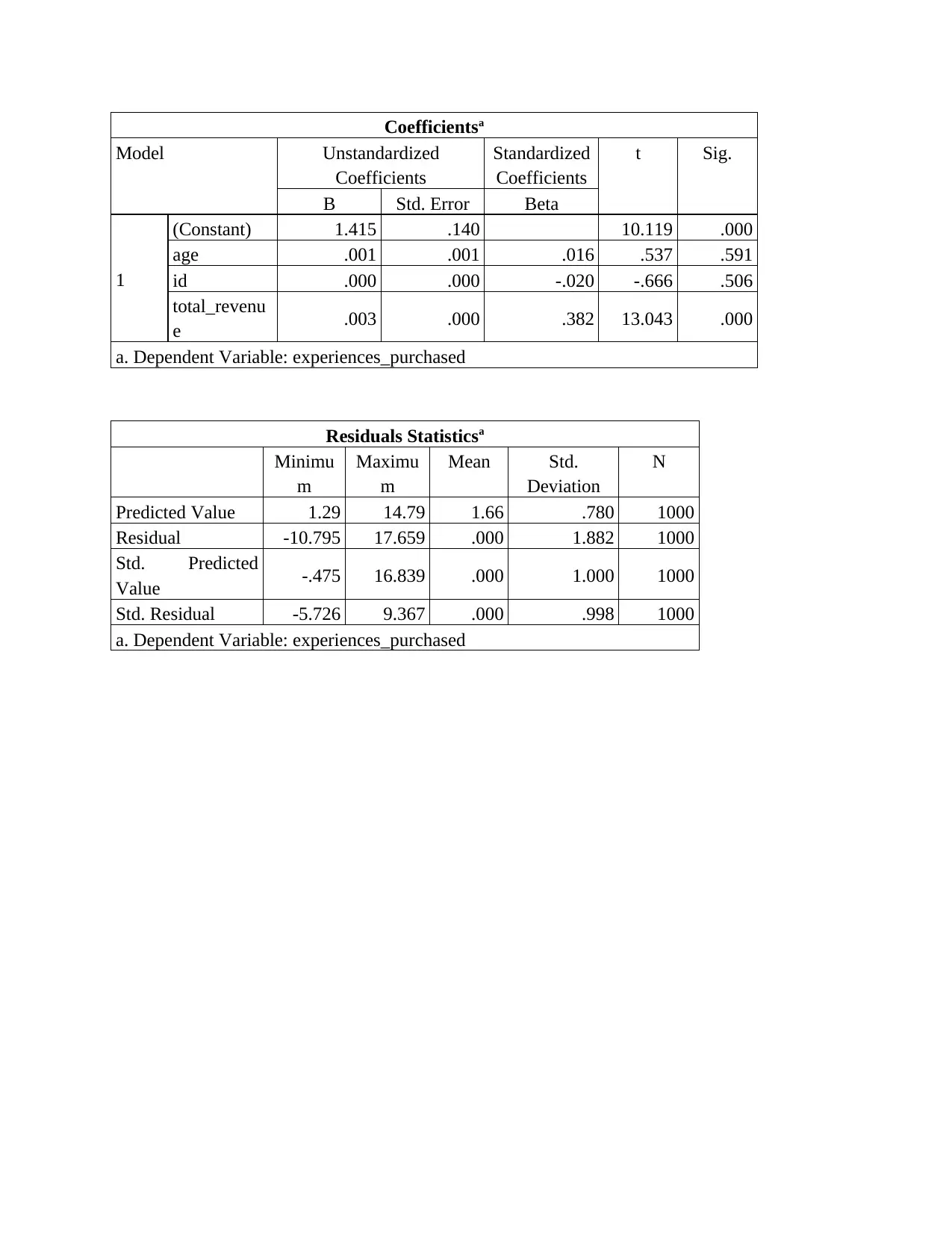
Coefficientsa
Model Unstandardized
Coefficients
Standardized
Coefficients
t Sig.
B Std. Error Beta
1
(Constant) 1.415 .140 10.119 .000
age .001 .001 .016 .537 .591
id .000 .000 -.020 -.666 .506
total_revenu
e .003 .000 .382 13.043 .000
a. Dependent Variable: experiences_purchased
Residuals Statisticsa
Minimu
m
Maximu
m
Mean Std.
Deviation
N
Predicted Value 1.29 14.79 1.66 .780 1000
Residual -10.795 17.659 .000 1.882 1000
Std. Predicted
Value -.475 16.839 .000 1.000 1000
Std. Residual -5.726 9.367 .000 .998 1000
a. Dependent Variable: experiences_purchased
Model Unstandardized
Coefficients
Standardized
Coefficients
t Sig.
B Std. Error Beta
1
(Constant) 1.415 .140 10.119 .000
age .001 .001 .016 .537 .591
id .000 .000 -.020 -.666 .506
total_revenu
e .003 .000 .382 13.043 .000
a. Dependent Variable: experiences_purchased
Residuals Statisticsa
Minimu
m
Maximu
m
Mean Std.
Deviation
N
Predicted Value 1.29 14.79 1.66 .780 1000
Residual -10.795 17.659 .000 1.882 1000
Std. Predicted
Value -.475 16.839 .000 1.000 1000
Std. Residual -5.726 9.367 .000 .998 1000
a. Dependent Variable: experiences_purchased
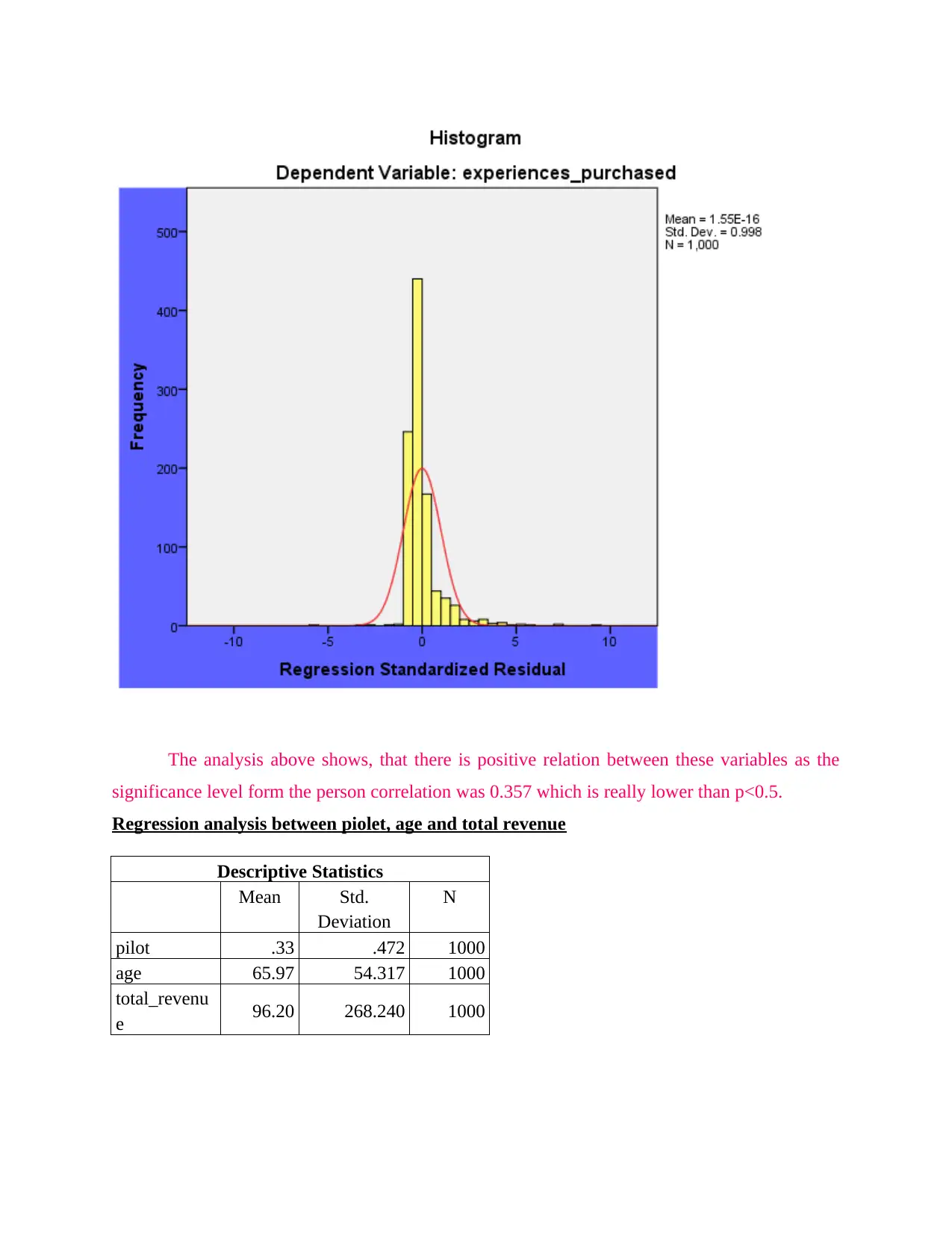
The analysis above shows, that there is positive relation between these variables as the
significance level form the person correlation was 0.357 which is really lower than p<0.5.
Regression analysis between piolet, age and total revenue
Descriptive Statistics
Mean Std.
Deviation
N
pilot .33 .472 1000
age 65.97 54.317 1000
total_revenu
e 96.20 268.240 1000
significance level form the person correlation was 0.357 which is really lower than p<0.5.
Regression analysis between piolet, age and total revenue
Descriptive Statistics
Mean Std.
Deviation
N
pilot .33 .472 1000
age 65.97 54.317 1000
total_revenu
e 96.20 268.240 1000
⊘ This is a preview!⊘
Do you want full access?
Subscribe today to unlock all pages.

Trusted by 1+ million students worldwide

Correlations
pilot age total_revenue
Pearson
Correlation
pilot 1.000 .040 .080
age .040 1.000 -.012
total_revenu
e .080 -.012 1.000
Sig. (1-tailed)
pilot . .105 .005
age .105 . .355
total_revenu
e .005 .355 .
N
pilot 1000 1000 1000
age 1000 1000 1000
total_revenu
e 1000 1000 1000
Model Summaryb
Model R R Square Adjusted R
Square
Std. Error of
the Estimate
1 .090a .008 .006 .470
a. Predictors: (Constant), total_revenue, age
b. Dependent Variable: pilot
ANOVAa
Model Sum of
Squares
df Mean
Square
F Sig.
1
Regression 1.806 2 .903 4.079 .017b
Residual 220.638 997 .221
Total 222.444 999
a. Dependent Variable: pilot
b. Predictors: (Constant), total_revenue, age
Coefficientsa
Model Unstandardized
Coefficients
Standardized
Coefficients
t Sig.
pilot age total_revenue
Pearson
Correlation
pilot 1.000 .040 .080
age .040 1.000 -.012
total_revenu
e .080 -.012 1.000
Sig. (1-tailed)
pilot . .105 .005
age .105 . .355
total_revenu
e .005 .355 .
N
pilot 1000 1000 1000
age 1000 1000 1000
total_revenu
e 1000 1000 1000
Model Summaryb
Model R R Square Adjusted R
Square
Std. Error of
the Estimate
1 .090a .008 .006 .470
a. Predictors: (Constant), total_revenue, age
b. Dependent Variable: pilot
ANOVAa
Model Sum of
Squares
df Mean
Square
F Sig.
1
Regression 1.806 2 .903 4.079 .017b
Residual 220.638 997 .221
Total 222.444 999
a. Dependent Variable: pilot
b. Predictors: (Constant), total_revenue, age
Coefficientsa
Model Unstandardized
Coefficients
Standardized
Coefficients
t Sig.
Paraphrase This Document
Need a fresh take? Get an instant paraphrase of this document with our AI Paraphraser
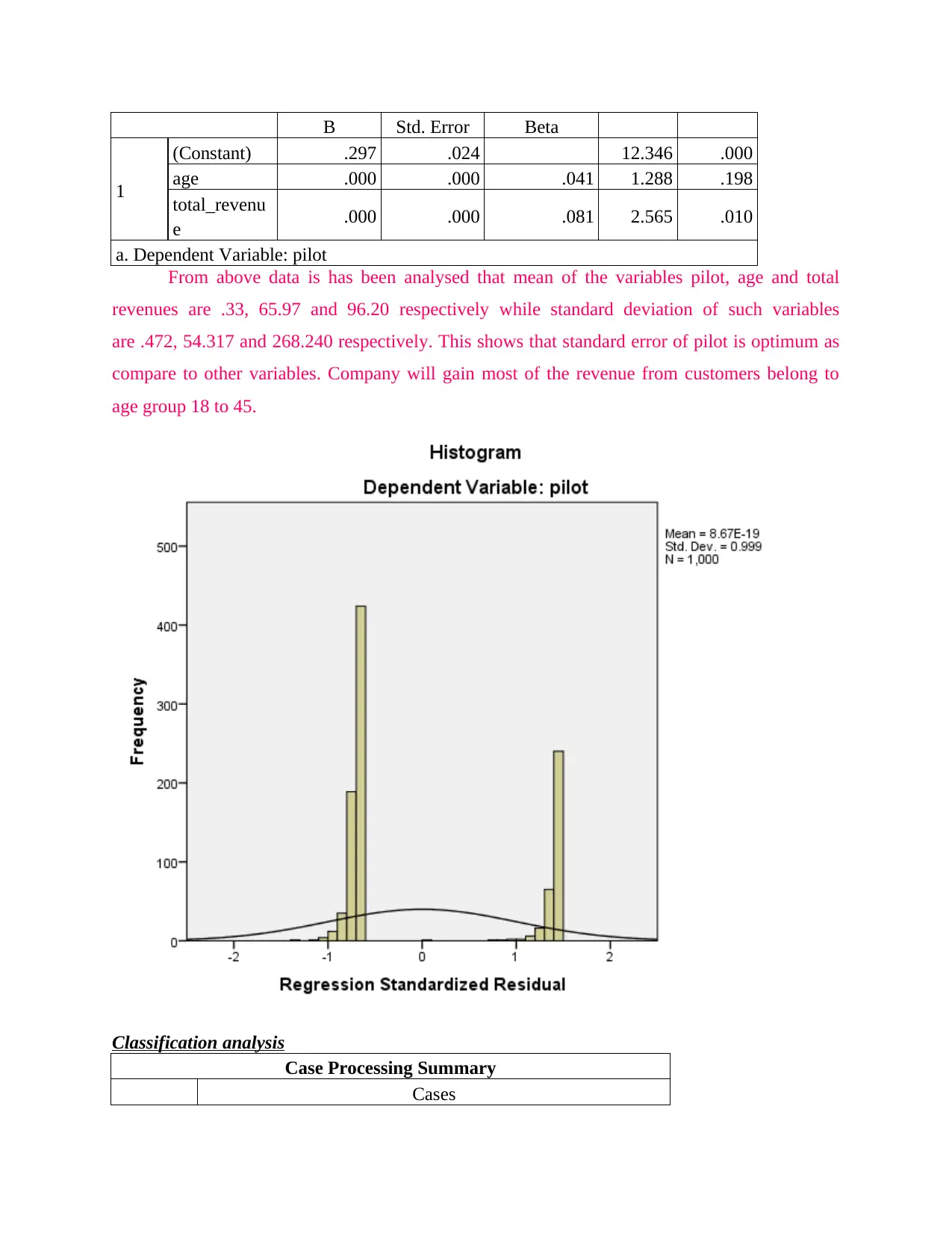
B Std. Error Beta
1
(Constant) .297 .024 12.346 .000
age .000 .000 .041 1.288 .198
total_revenu
e .000 .000 .081 2.565 .010
a. Dependent Variable: pilot
From above data is has been analysed that mean of the variables pilot, age and total
revenues are .33, 65.97 and 96.20 respectively while standard deviation of such variables
are .472, 54.317 and 268.240 respectively. This shows that standard error of pilot is optimum as
compare to other variables. Company will gain most of the revenue from customers belong to
age group 18 to 45.
Classification analysis
Case Processing Summary
Cases
1
(Constant) .297 .024 12.346 .000
age .000 .000 .041 1.288 .198
total_revenu
e .000 .000 .081 2.565 .010
a. Dependent Variable: pilot
From above data is has been analysed that mean of the variables pilot, age and total
revenues are .33, 65.97 and 96.20 respectively while standard deviation of such variables
are .472, 54.317 and 268.240 respectively. This shows that standard error of pilot is optimum as
compare to other variables. Company will gain most of the revenue from customers belong to
age group 18 to 45.
Classification analysis
Case Processing Summary
Cases
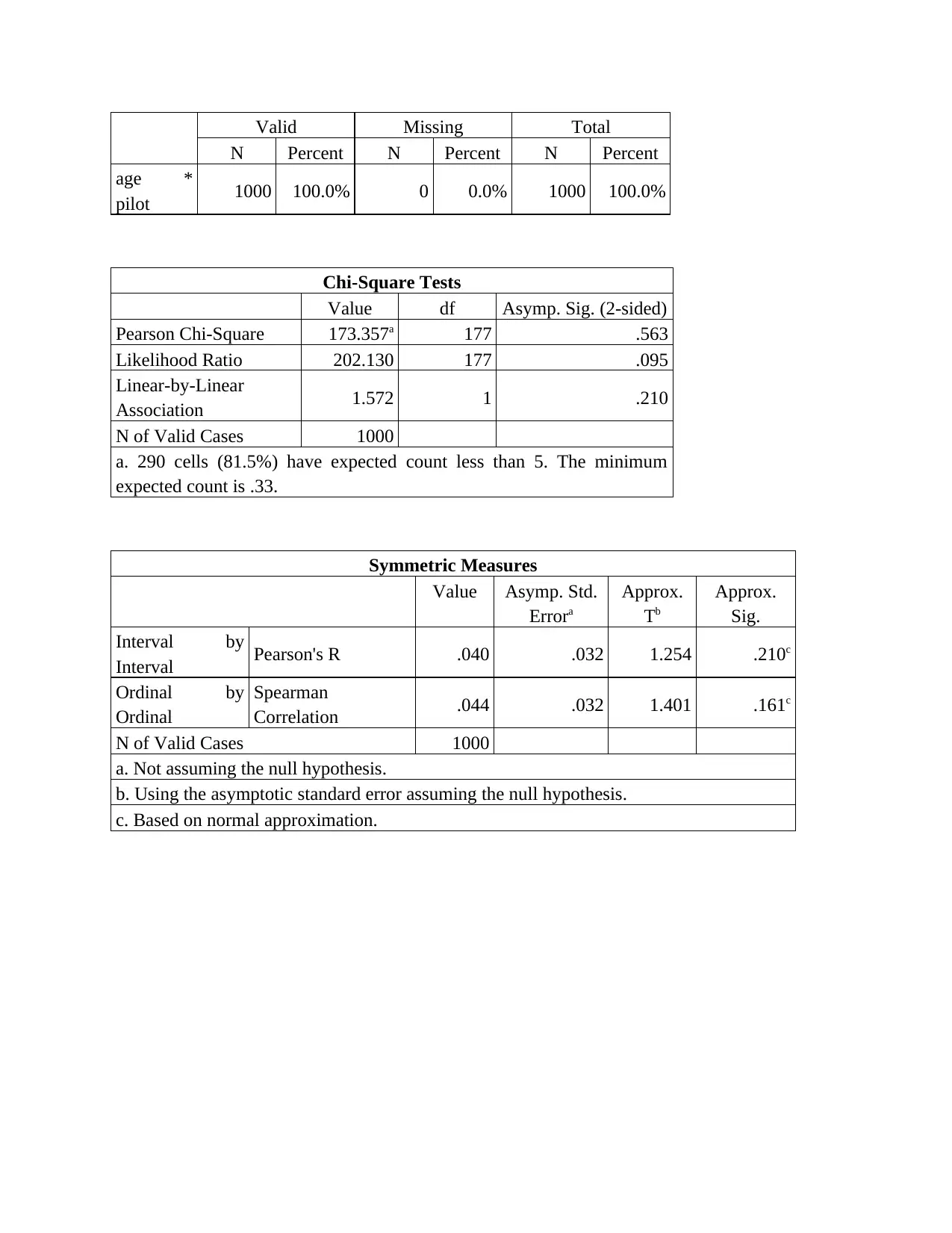
Valid Missing Total
N Percent N Percent N Percent
age *
pilot 1000 100.0% 0 0.0% 1000 100.0%
Chi-Square Tests
Value df Asymp. Sig. (2-sided)
Pearson Chi-Square 173.357a 177 .563
Likelihood Ratio 202.130 177 .095
Linear-by-Linear
Association 1.572 1 .210
N of Valid Cases 1000
a. 290 cells (81.5%) have expected count less than 5. The minimum
expected count is .33.
Symmetric Measures
Value Asymp. Std.
Errora
Approx.
Tb
Approx.
Sig.
Interval by
Interval Pearson's R .040 .032 1.254 .210c
Ordinal by
Ordinal
Spearman
Correlation .044 .032 1.401 .161c
N of Valid Cases 1000
a. Not assuming the null hypothesis.
b. Using the asymptotic standard error assuming the null hypothesis.
c. Based on normal approximation.
N Percent N Percent N Percent
age *
pilot 1000 100.0% 0 0.0% 1000 100.0%
Chi-Square Tests
Value df Asymp. Sig. (2-sided)
Pearson Chi-Square 173.357a 177 .563
Likelihood Ratio 202.130 177 .095
Linear-by-Linear
Association 1.572 1 .210
N of Valid Cases 1000
a. 290 cells (81.5%) have expected count less than 5. The minimum
expected count is .33.
Symmetric Measures
Value Asymp. Std.
Errora
Approx.
Tb
Approx.
Sig.
Interval by
Interval Pearson's R .040 .032 1.254 .210c
Ordinal by
Ordinal
Spearman
Correlation .044 .032 1.401 .161c
N of Valid Cases 1000
a. Not assuming the null hypothesis.
b. Using the asymptotic standard error assuming the null hypothesis.
c. Based on normal approximation.
⊘ This is a preview!⊘
Do you want full access?
Subscribe today to unlock all pages.

Trusted by 1+ million students worldwide
1 out of 21
Related Documents
Your All-in-One AI-Powered Toolkit for Academic Success.
+13062052269
info@desklib.com
Available 24*7 on WhatsApp / Email
![[object Object]](/_next/static/media/star-bottom.7253800d.svg)
Unlock your academic potential
Copyright © 2020–2025 A2Z Services. All Rights Reserved. Developed and managed by ZUCOL.





